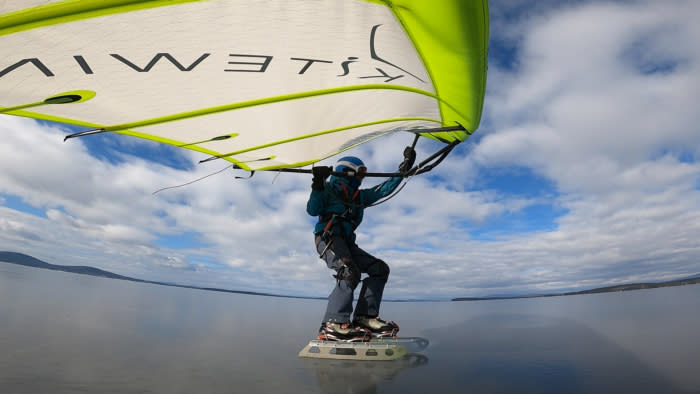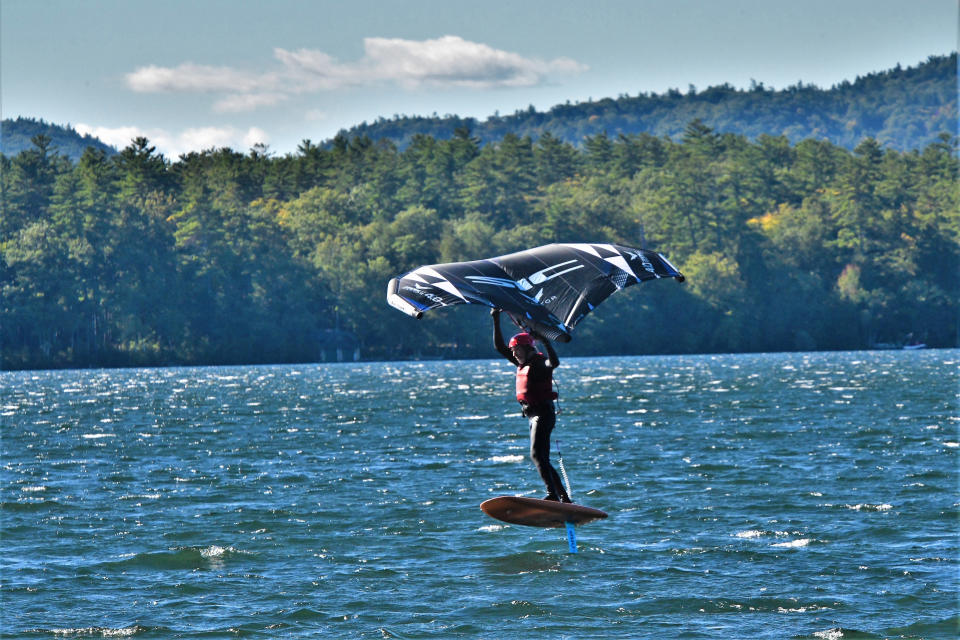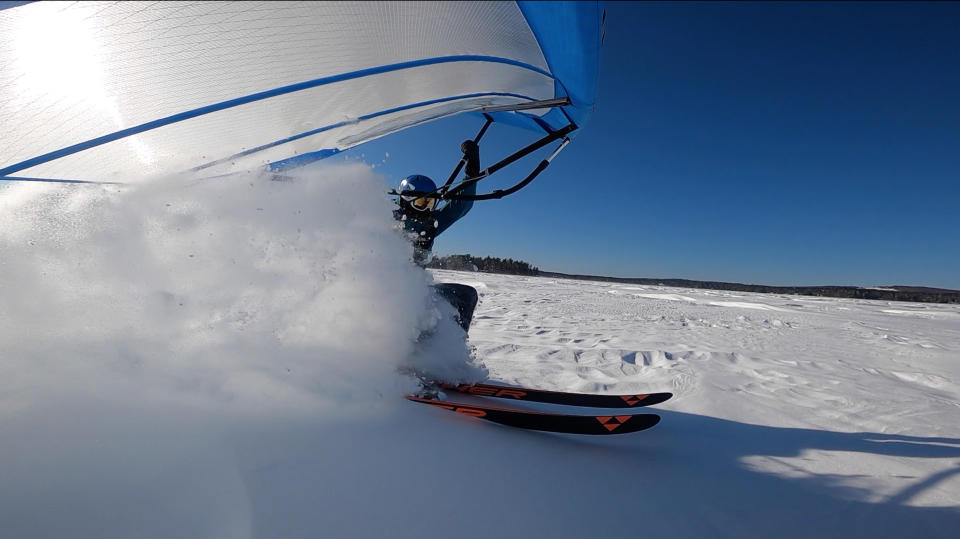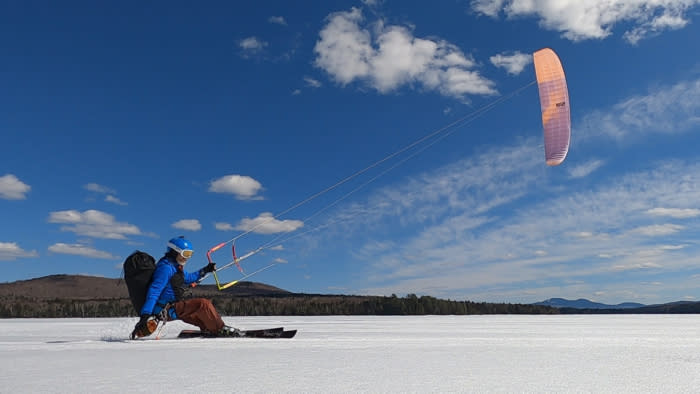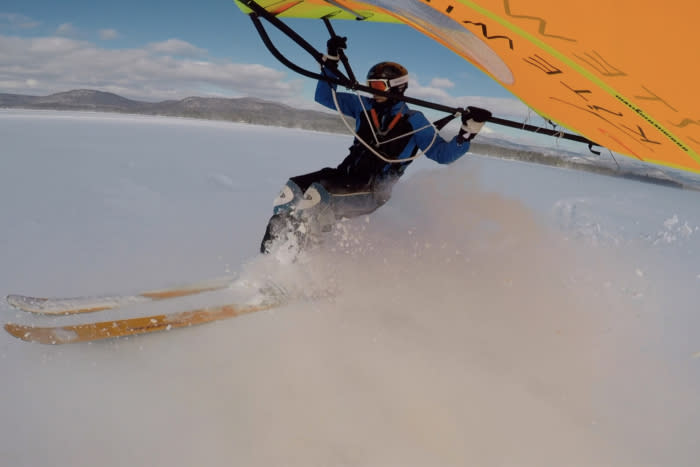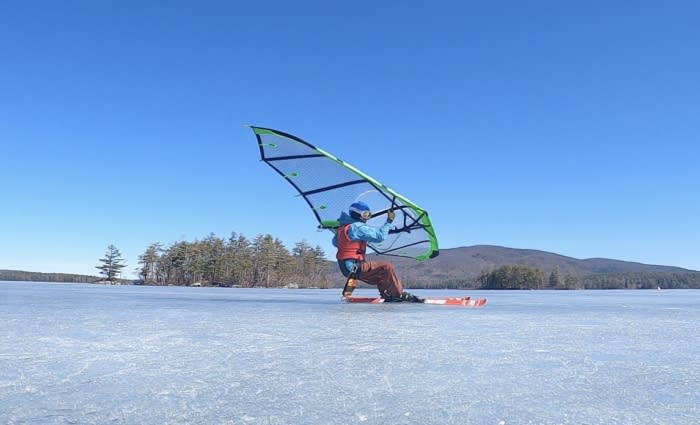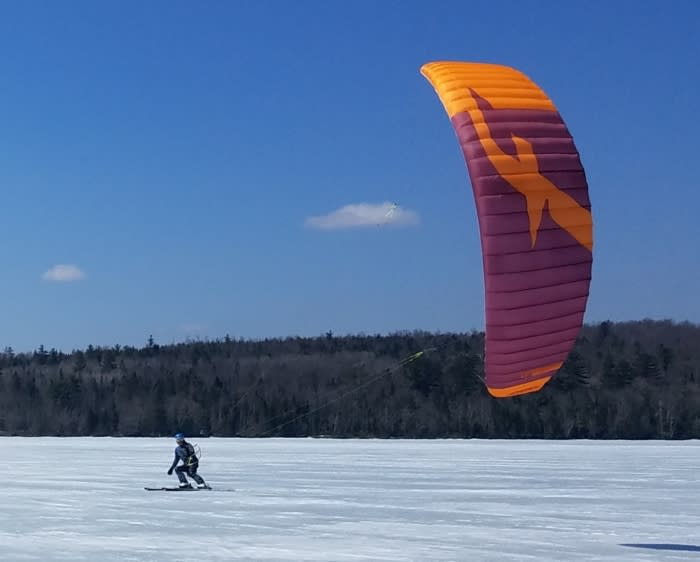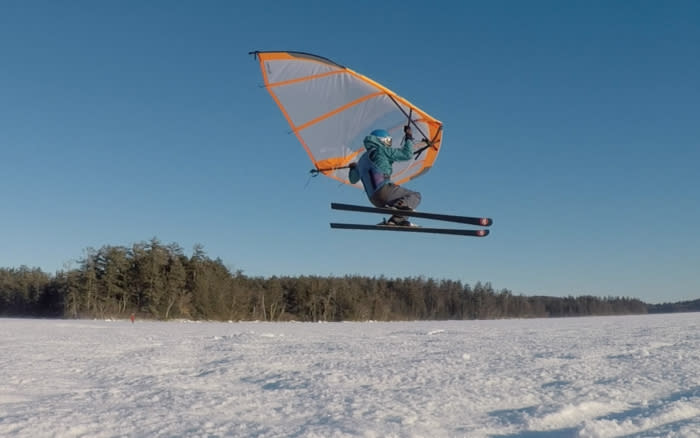Kitewing in Winter, Wing Foil in Summer: Retired World Cup Skier’s Year-Round Thrills
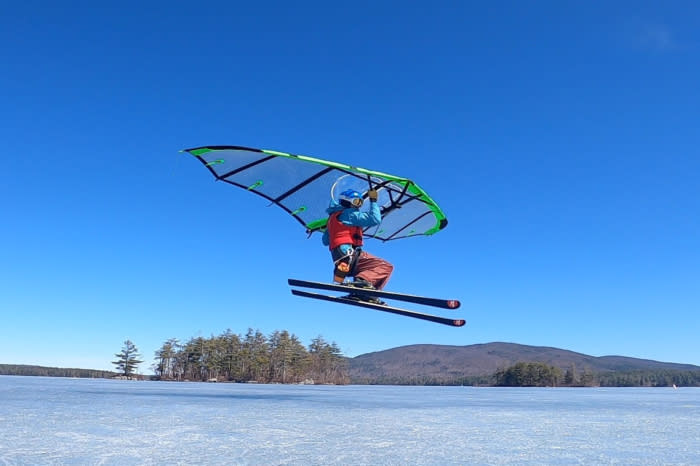
Even after he retired as a pro skier, Eric Morse has long sought the rush of sailing over snow and ice. When he competed in freestyle ballet skiing in the early ’90s, it was an altogether new form of the sport. Now, 30 years later, he’s discovered a new passion for another cutting-edge outdoor activity, leveraging his skills as a skier and the power of wind.
“Kitewing is just like sailing, but on ice,” Morse told GearJunkie. “It’s knowing what the wind is doing and being able to change direction quickly when the wind changes. It’s something to do every winter, every day. There are only very few times of year when I don’t check the wind forecast for the day. And in the summer, I pull out the wing foil so I can get out there year round.”
In 1990 and 1991, Morse was a U.S. Freestyle Ski Team member, competing in ski ballet. He’s also a passionate backcountry and Nordic skier. He loves skiing in all of its forms. But when he discovered Kitewing skiing in 2011, it was something new to him — and its sister sport, wing foiling, was something he could do in the warmer months as well.
Since then, he’s become an extremely avid Kitewing skier and wing foiler, and as a landscape and portrait photographer, he’s taking some rad photos of his wind-powered exploits. GearJunkie connected with Morse to talk about these unique sports he’s taken up, how he got into them, and what they entail.
Meet Winged Sports Fanatic Eric Morse: Kitewing Skiing & Wing Foiling
GearJunkie: How did you get into Kitewing skiing?
Eric Morse: My friend Martin got me into Kitewing back in 2011. I windsurfed when I lived in Oregon, but sold all my gear when I moved back to New Hampshire. Then I sailed catamarans, which are a little better for the gusty winds we have here on the East Coast. When I found out I could sail in the wintertime and not have to buy a lift ticket, I was hooked.
What is the difference between kite skiing, Kitewing skiing, and wing foiling?
A Kitewing is a handheld wing. It has a wing and a sail. It’s kind of like a windsurfer, but it’s not mounted to the board. It’s like a tiny hang glider, and you can sail it on either side of you just by switching your hands. Kitewing is better for ice and big crazy wind. When I am going 50 mph, the Kitewing is a lot safer.
Kite skiing is a kite on 20-25m lines, so it’s like kite surfing, but on skis … I tend to go kiting if there is powder because it’s more fun. When I first started, I was constantly looking up at the kite and not looking where I was going. It was a big learning curve to use the kite. If you know how to ski and you know how to windsurf, you pick it up right away. In the summer, I use the wing foil on the water.
I would strongly recommend people take a kite skiing lesson, as there is a lot to learn.
Do you use Kitewings of different sizes for different conditions?
Kitewing makes its wings in various sizes, and you use bigger wings in light air and smaller wings in strong wind. The Kitewings range from 3.0 to 4.0, 4.6 to 5.5, and 6.0 to 7.0 square meters.
I have gone fastest on the 3.0 (58 mph) and had top average speeds of 29 mph on a 77-mile tour with a carbon fiber frame. The 4.6 is my favorite wing because it is a high-aspect design, meaning that it is wider from wing tip to wing tip and shorter from front to back.
The low-aspect designs are more user-friendly for beginners, and the high-aspect designs give up some stability and gain efficiency. Kitewings will keep on sailing even when the wind drops off and you keep on cruising along until you hit the next gust. This is especially important when touring around islands because you need to sail through the lulls when passing the lee side of the islands.
Touring is my favorite part of Kitewing skiing. I enjoy taking an adventure around the bigger lakes and exploring new areas. Sometimes, the conditions are not as good on the other side, but it is fun to see the new scenery.
What kind of gear do you take with you when you go Kitewing skiing?
On ice, you want to use a GS or a downhill ski that really wants to go straight so you are not fighting the ski. Then you sharpen the edges real sharp and can lean way over and hold an edge on the barest ice ever. You don’t want to use shape skis because they don’t hold their edge. You want skis that will go straight for a long time. Most skis are designed to turn, so the racing skis work better for Kitewing [skiing].
I also sometimes use recreational speed skates with the Kitewing because skating is cool and a fun way to explore the lakes. The edge hold on the ice is more secure with the skates.
I use powder skis for snow and race skis for ice. I like a straight ski with not a lot of side cut; I wear a helmet, goggles, and a wind sailing harness, and the lines are on the wing frame itself. You can let go of one hand and keep sailing.
I wear regular ski clothes but a bit warmer because we are out in the strongest winds in the middle of the lake, so it tends to be colder. We tend to get the best wind when it’s really cold. I use Alpine boots or Telemark boots. You can even use cross-country boots, but I usually just use my GS gear.
The safety gear is also really important. You want 3 inches of ice before you go out there. Four inches of black ice will support a ton of weight. We use an ice probe to test the ice.
We also use these things called ice claws that are around your neck in a holster. If you fell through the ice, you could pull the ice claw out and use it to pull yourself back onto the ice. The ice is slippery, and you are wet, and you are wearing skis, so you are fighting a lot to get out of the water. A life jacket is a good idea, too.
What does Kitewing skiing feel like?
It feels amazing because you are totally free. There are hardly any people out on the lake apart from a few ice fishermen. It’s beautiful scenery, no lift lines — no lift rides even. You are just going the whole time until you want to take a break. You can strap into a harness so the pressure is off your arms, and it’s just a leg workout.
I can go 30-40 miles an hour and have topped out at 58 mph. I often go for 100 miles over the course of 5 to 6 hours.
Kitewing is not catching on like wing foiling. It’s unbelievable how popular wing foiling is becoming. The two sports are very similar. We sail on a hard wing that has carbon-fiber glass tubes supporting it and aluminum battens in the sail.
It doesn’t take much wind to go pretty quickly. You go faster than the wind, and you can carve those GS skis downwind rising the carve with the leading edge going forward. But you are going faster than the wind straight behind you so the wing doesn’t flip over your head and stays in position.
I usually only go 5 or 6 feet off the ground. I’m not trying to win any championships. If you don’t land smoothly, it’s going to hurt; it’s not water.
You were on the cutting edge of freestyle skiing even before aerials and moguls were Olympic sports. Do you see a parallel with your new fascination with winged sports?
I’m sure some of the techniques I learned as a freestyle skier have helped me recover from an almost crash with balance and agility. I feel very comfortable in the air on a Kitewing so that was intuitive from my freestyle days.
I was a freestyle ballet skier. That and kitewing skiing are both super-obscure sports and I kind of like that aspect. Ballet skiing ceased to exist when it didn’t become an Olympic sport.
Kitewing skiing is such a new sport; how does a newbie get started?
The best thing is to go to kitewing.com and look to see what wings are for sale. Not many places offer demos since it’s closely enough related to a hang glider that would be a tough thing to insure. The company was started in Finland in the ’90s, but [kitewing skiing] didn’t catch on until more recently.
You can also go to the Facebook page for your area. There are all kinds of local groups, and the best thing is to meet up with someone and borrow a wing. Some people start this sport by using inflatable wings that are harder to break. If you feel uncomfortable, you just let go, and the wing doesn’t break; it just floats away.
Did anything surprise you about the sport when you first got into Kitewing?
Back when I started Kitewing skiing in 2011, the equipment wasn’t as good as it is now. I crashed my wing several times when I started and would have to walk all the way back to the car across the ice. I learned not to jump when it’s gusty because I would crash and break my gear. Early on, I had to replace a bunch of my gear. If the ski tip gets stuck in the snow, it just stops you then you break the wing.
Any parting thoughts?
I just love it. Kitewing [skiing] is amazing. Right now, it’s getting windy and it wasn’t supposed to be windy today, and I’m wishing I was out there sailing.
The post Kitewing in Winter, Wing Foil in Summer: Retired World Cup Skier’s Year-Round Thrills appeared first on GearJunkie.
